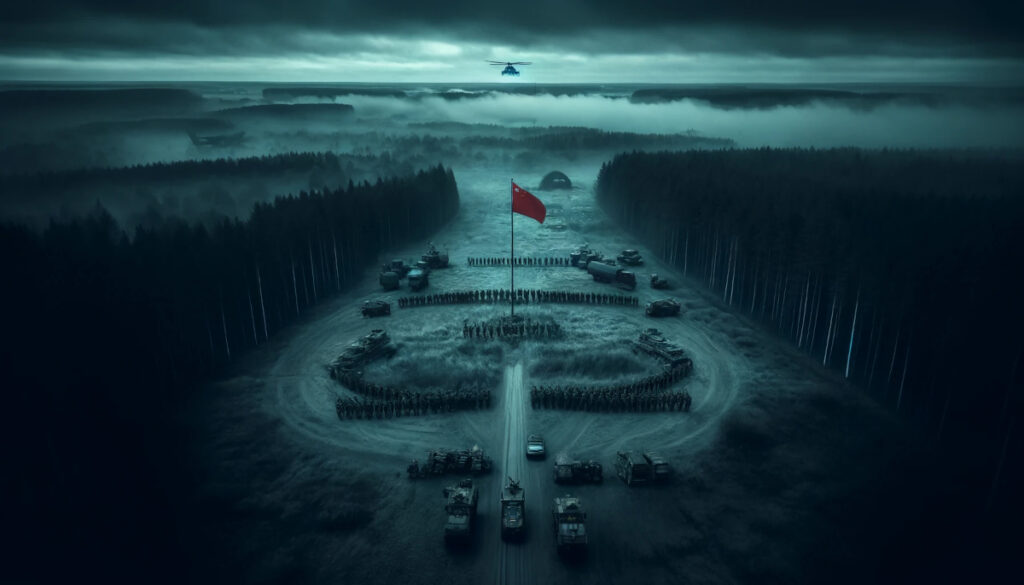
Eagle Assault 2024 (DALL-E)
China and Belarus have commenced joint military exercises near the Polish and Ukrainian borders, heightening geopolitical tensions in Eastern Europe. These drills, dubbed “Eagle Assault,” mark an unprecedented deployment of Chinese military personnel so close to the NATO alliance’s eastern frontier and the ongoing conflict in Ukraine.
Context and Motivations
The military exercises, which began on July 8th are strategically located near the Belarusian city of Brest, a mere five kilometers from the Polish border and just 30 miles from Ukraine’s northern frontier. The Belarusian and Chinese defense ministries have framed these operations as anti-terrorism drills, focusing on night landings, overcoming water obstacles, and urban combat scenarios.
Belarusian officials claim that the exercises are a response to the growing NATO presence along their borders, as well as alleged provocations from Ukraine. Vladimir Kupriyanyuk, the deputy head of the Belarusian general staff, emphasized the need for readiness against what he described as Western aggression and Ukrainian provocations. The drills also align with Belarus’s recent integration into the Shanghai Cooperation Organization (SCO), solidifying its military and strategic ties with China and Russia.
Strategic Implications
The timing of these exercises is particularly notable as they coincide with a NATO summit in Washington, where member countries are expected to discuss additional support for Ukraine and measures to bolster border defenses. The presence of Chinese troops in Belarus for the first time since 2018 underscores a growing military cooperation between China, Belarus, and Russia, further complicating the security dynamics in the region.
Belarus, a steadfast ally of Russia, has played a critical role in supporting Moscow’s military operations since the invasion of Ukraine in 2022, offering logistical support and hosting Russian military assets. This alignment is further solidified by Belarus’s recent membership in the Shanghai Cooperation Organization (SCO), a bloc led by China and Russia, which positions itself as a counterbalance to Western influence.
These drills serve not only as a show of military strength but also as a strategic maneuver to challenge NATO’s influence in Eastern Europe. The exercises are likely intended to signal to NATO that Belarus and its allies are prepared to counter any perceived threats aggressively. This move also highlights the deepening ties between China and Belarus, which have been growing in response to their mutual support for Russia’s actions in Ukraine.
Regional Reactions
The exercises have sparked concerns among NATO members, particularly Poland and Lithuania, who view this show of military strength as a direct threat. Polish Defense Minister Władysław Kosiniak-Kamysz highlighted the need for enhanced border protection measures at the NATO summit, pointing to a “hybrid war” being waged on the borders of Poland, Latvia, Lithuania, and Estonia.
NATO’s response to these drills has been one of heightened vigilance and readiness. The alliance has increased its military presence in Eastern Europe in recent years, aiming to deter any potential aggression from Russia and its allies. However, the presence of Chinese troops so close to NATO’s borders adds a new layer of complexity to the region’s security landscape. The exercises are a clear signal that Belarus and its allies are willing to escalate tensions to assert their interests.
Speculation on Broader Conflict
The strategic implications of these drills are profound, raising the specter of a broader conflict in Europe. The presence of Chinese troops in Belarus, conducting exercises near the Polish and Ukrainian borders, can be seen as a provocative move that might escalate into a larger confrontation. If NATO perceives these exercises as a direct threat, it could lead to increased military deployments and further militarization of the region.
Moreover, the drills could embolden Russia to take more aggressive actions in Ukraine, knowing that it has the backing of both Belarus and China. This tripartite alliance poses a significant challenge to NATO, which must balance its support for Ukraine with the need to avoid direct confrontation with China and Russia.
The situation is further complicated by the ongoing conflict in Ukraine. Any miscalculation or accidental engagement between NATO forces and the Chinese or Belarusian military could quickly escalate into a broader war. The proximity of these drills to active conflict zones increases the risk of such incidents occurring.
The joint military exercises by China and Belarus near the Polish and Ukrainian borders represent a significant escalation in regional tensions, with potential implications for NATO’s strategic planning and security posture. As Eastern Europe remains a flashpoint in global geopolitics, the actions of China, Belarus, and Russia will undoubtedly continue to be closely monitored by NATO and its allies.








